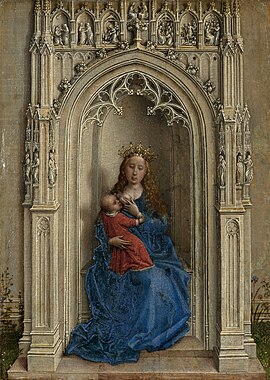
Back Mare de Déu i Nen entronitzats (Van der Weyden) Catalan Virgen con el Niño entronizados Spanish La Sainte Vierge avec l'Enfant Jésus French A Virgem e o Menino Jesus entronizados Portuguese
| Virgin and Child Enthroned | |
|---|---|
 | |
| Artist | Rogier van der Weyden |
| Year | c. 1430–1432 |
| Medium | oil on panel |
| Dimensions | 15.8 cm × 11.4 cm (6.2 in × 4.5 in) |
| Location | Museo Thyssen-Bornemisza, Madrid |
The Virgin and Child Enthroned (also known as the Thyssen Madonna) is a small oil-on-oak panel painting dated c. 1433, usually attributed to the Early Netherlandish artist Rogier van der Weyden.[1] It is closely related to his Madonna Standing, completed during the same period. The panel is filled with Christian iconography, including representations of prophets, the Annunciation, Christ's infancy and resurrection, and Mary's Coronation. It is generally accepted as the earliest extant work by van der Weyden, one of three works attributed to him of the Virgin and Child enclosed in a niche on an exterior wall of a Gothic church. The panel is housed in the Museo Thyssen-Bornemisza in Madrid.
The panel seems to be the left-hand wing of a dismantled diptych, perhaps with the Saint George and the Dragon panel now in the National Gallery of Art, Washington, D.C. As an early van der Weyden, it takes influence from Robert Campin and Jan van Eyck. Van der Weyden served his apprenticeship under Campin, and the older master's style is noticeable in the architecture of the niche, the Virgin's facial type, her exposed breast and the treatment of her hair.
- ^ The panel was attributed at various times in the late 19th and early 20th centuries to Hubert van Eyck and Jan van Eyck. See Hand et al. (2006), 324